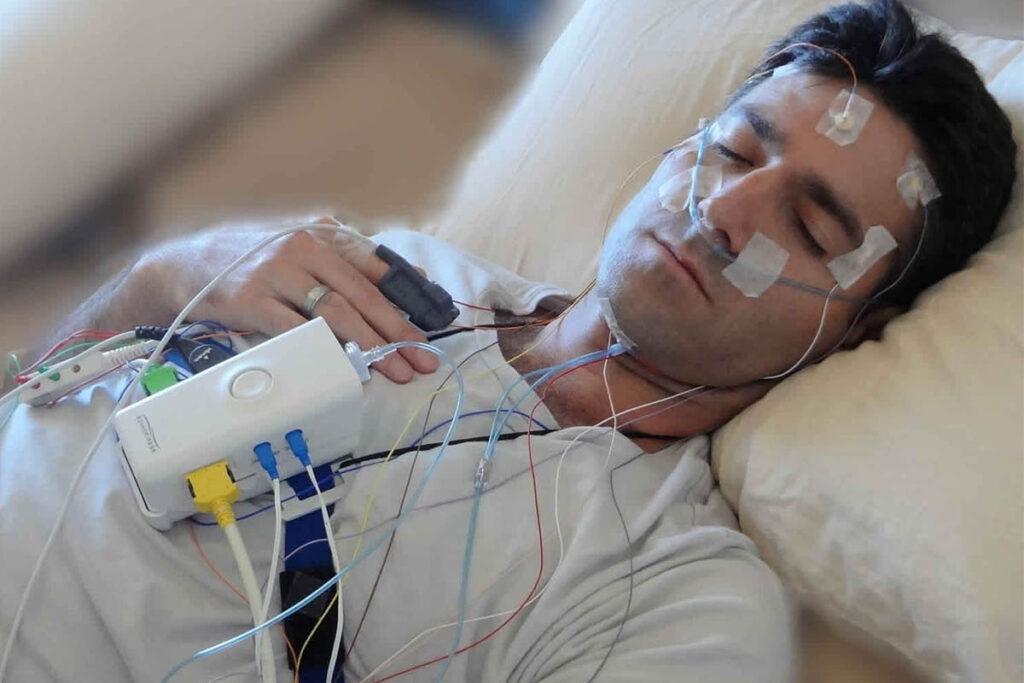Sleep Lab
Comprehensive Sleep Disorder Diagnosis and Treatment
At Deva Institute of Healthcare and Research, our state-of-the-art Sleep Lab is dedicated to diagnosing and treating a wide range of sleep disorders. Our highly experienced team utilizes advanced technology to provide accurate assessments and personalized treatment plans.

During polysomnography
You arrive at the sleep center in the evening for polysomnography and stay overnight. You may bring items you use for your bedtime routine, and you can sleep in your own nightclothes.
The room where polysomnography is done is similar to a hotel room, and it’s dark and quiet during the test. You won’t share the room with anyone else. Each room has its own bathroom.
The sleeping area will typically have a low-light video camera, so the polysomnography technologists monitoring you can see what’s happening in the room when the lights are out. It also has an audio system, so they can talk to you and hear you from their monitoring area outside the room.
After you get ready for bed, one of the technologists will place sensors on your scalp, temples, chest and legs using a mild adhesive, such as glue or tape. The sensors are connected by wires to a computer, but the wires are long enough to let you move around in bed. A small clip also is placed on your finger or ear to monitor the level of oxygen in your blood.
While you sleep, a technologist monitors yours:
- Brain waves
- Eye movements
- Heart rate
- Breathing pattern
- Blood oxygen level
- Body position
- Chest and abdominal movement
- Limb movement
- Snoring and other noise you may make as you sleep
Polysomnography technologists monitor you throughout the night. If you need assistance, you can talk to them through the monitoring equipment. They can come into the room to detach the wires if you need to get up during the night.
During the study, the technologist may have you try a positive airway pressure (PAP) machine for sleep apnea. This is a device that consists of a tight-sealing nosepiece through which a gentle stream of air is delivered to enhance your breathing.
Continuous positive airway pressure (CPAP) is one type of PAP machine. CPAP devices deliver a constant stream of air that keeps the airway passages open while you sleep.
For some people, bi-level positive airway pressure (biPap or bPap) machines may be a more comfortable choice. These devices deliver more pressure while you’re breathing in, and lower pressure when you exhale.
You may have the opportunity to try on a PAP device before the sleep study begins so that you are not surprised by it if the technologist suggests you try the device later in the night. If necessary, oxygen also may be used during the study to bolster your breathing.
Although you probably won’t fall asleep as easily or sleep as well at the sleep center as you do at home, this usually doesn’t affect the test results. A full night’s sleep isn’t required to obtain accurate polysomnography results.
After polysomnography
In the morning, the sensors are removed, and you may leave the sleep center. You’re given an appointment for a follow-up visit with the doctor who recommended the test. You can return to your usual activities after polysomnography
Results
The measurements recorded during polysomnography provide a great deal of information about your sleep patterns. For example:
- Brain waves and eye movements during sleep can help your health care team assess your sleep stages and identify disruptions in the stages that may occur due to sleep disorders such as narcolepsy and REM sleep behavior disorder.
- Heart and breathing rate changes and changes in blood oxygen that are abnormal during sleep may suggest sleep apnea.
- Correct settings for PAP or oxygen in case your doctor would like to prescribe these for home use.
- Frequent leg movements that disrupt your sleep may indicate periodic limb movement disorder.
- Unusual movements or behaviors during sleep may be signs of REM sleep behavior disorder or another sleep disorder.
The information gathered during polysomnography is evaluated first by a polysomnography technologist, who uses the data to chart your sleep stages and cycles. Then that information is reviewed by your treating doctor.
Why Choose Our Sleep Lab?
Expert Team: Our specialists are trained in sleep medicine and work collaboratively to ensure the best outcomes for our patients.
Advanced Technology: We use cutting-edge equipment to monitor and analyze sleep patterns, ensuring precise diagnosis.
Personalized Care: Each patient receives a customized treatment plan tailored to their specific needs and conditions.
Comfortable Environment: Our Sleep Lab is designed to provide a comfortable and relaxing atmosphere, making the diagnostic process as smooth as possible.
Services Offered
Polysomnography (Sleep Study): Comprehensive overnight monitoring to diagnose sleep apnea, insomnia, and other sleep disorders.
Multiple Sleep Latency Test (MSLT): Evaluates daytime sleepiness and narcolepsy.
Maintenance of Wakefulness Test (MWT): Assesses the ability to stay awake in a quiet, non-stimulating environment.
Home Sleep Apnea Testing (HSAT): Convenient at-home testing for sleep apnea.
For more information or to schedule an appointment, please contact us
